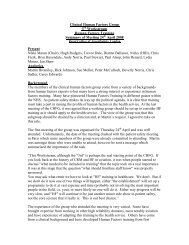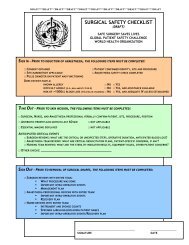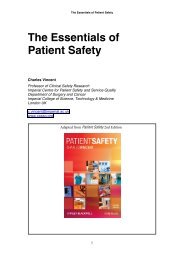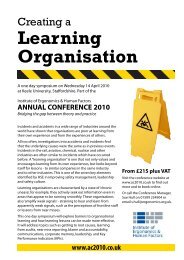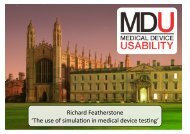Read an anonymous version of Elaine's report, the Inquest Verdict ...
Read an anonymous version of Elaine's report, the Inquest Verdict ...
Read an anonymous version of Elaine's report, the Inquest Verdict ...
You also want an ePaper? Increase the reach of your titles
YUMPU automatically turns print PDFs into web optimized ePapers that Google loves.
) Anaes<strong>the</strong>tic technique <strong>an</strong>d m<strong>an</strong>agement <strong>of</strong> <strong>the</strong> airwayI have endeavoured to construct a timescale for events during <strong>the</strong> <strong>an</strong>aes<strong>the</strong>tic but <strong>the</strong>re isno information recorded on <strong>the</strong> <strong>an</strong>aes<strong>the</strong>tic chart. The following is based on <strong>the</strong> o<strong>the</strong>rclinical notes <strong>an</strong>d comments for staff:08.35 Anaes<strong>the</strong>sia was induced with <strong>an</strong> infusion <strong>of</strong> remifent<strong>an</strong>il (0.3mcglkg/min) <strong>an</strong>d <strong>an</strong>intravenous injection <strong>of</strong> prop<strong>of</strong>ol 200mg (a very rapidly-acting <strong>an</strong>aes<strong>the</strong>tic agent). Theproposed airway m<strong>an</strong>agement was with a flexible laryngeal mask airway but it was notpossible to insert this due to inability to open <strong>the</strong> mouth as a consequence <strong>of</strong> increasedtone in <strong>the</strong> jaw muscles. This c<strong>an</strong> sometimes occur when <strong>an</strong>aes<strong>the</strong>sia is „light‟ <strong>an</strong>d isusually overcome by giving <strong>an</strong> additional dose <strong>of</strong> <strong>an</strong>aes<strong>the</strong>tic. In this case, Dr A gave<strong>an</strong>o<strong>the</strong>r 50 mg <strong>of</strong> prop<strong>of</strong>ol <strong>an</strong>d had a second attempt. He tried two sizes <strong>of</strong> laryngealmask (sizes 3 <strong>an</strong>d 4) but was unable to insert ei<strong>the</strong>r.08.37 At this stage, Mrs Bromiley‟s oxygenation beg<strong>an</strong> to deteriorate <strong>an</strong>d she lookedcy<strong>an</strong>osed (blue). Her oxygen saturation at this time was 75% (<strong>an</strong>ything less th<strong>an</strong> 90% issignific<strong>an</strong>tly low) <strong>an</strong>d her heart rate was raised.08.39 The oxygen saturation continued to deteriorate to a very low level (40%) over <strong>the</strong>next minute or so. Attempts to ventilate <strong>the</strong> lungs with 100% oxygen using a facemask<strong>an</strong>d oral airway proved extremely difficult.08.41-08.43 It was still proving near impossible to ventilate <strong>the</strong> lungs <strong>an</strong>d <strong>the</strong> oxygensaturation remained perilously low (40% - it might have been lower but I think <strong>the</strong>monitor had a lower limit <strong>of</strong> 40%). In combination to <strong>the</strong> extremely low oxygensaturation, <strong>the</strong> heart rate had declined to 69 bpm with a downward trend continuing to <strong>the</strong>low 40‟s. This is indicative <strong>of</strong> lack <strong>of</strong> oxygen to <strong>the</strong> heart.Dr A decided to attempt tracheal intubation at this stage to overcome <strong>the</strong> problems with<strong>the</strong> airway. He gave atropine 0.6 mg intravenously (a drug to counter <strong>the</strong> slow heart rate)<strong>an</strong>d suxamethonium 100 mg (a paralysing drug to allow insertion <strong>of</strong> <strong>the</strong> tracheal tube).At about this time, Dr A was joined by Dr B who had been about to start <strong>an</strong> operating listin <strong>the</strong> adjoining <strong>the</strong>atre.08.45 On insertion <strong>of</strong> <strong>the</strong> laryngoscope to allow insertion <strong>of</strong> <strong>the</strong> tracheal tube, it wasimpossible to see <strong>an</strong>y <strong>of</strong> <strong>the</strong> laryngeal (voicebox) <strong>an</strong>atomy. This view at laryngoscopy isclassified as Connack <strong>an</strong>d Leh<strong>an</strong>e grade IV <strong>an</strong>d me<strong>an</strong>s that tracheal intubation is likely tobe very difficult if not impossible. The oxygen saturation remained very low though <strong>the</strong>heart rate had increased to 64 bpm, probably as a result <strong>of</strong> <strong>the</strong> atropine.By about this time, o<strong>the</strong>r staff had been summoned to <strong>the</strong> <strong>an</strong>aes<strong>the</strong>tic room to provide <strong>an</strong>ynecessary assist<strong>an</strong>ce. Mr E also entered <strong>the</strong> <strong>an</strong>aes<strong>the</strong>tic room at about this time. Betweenattempts at laryngoscopy, ventilation still proved extremely difficult despite <strong>the</strong> use <strong>of</strong>four-h<strong>an</strong>ded attempts.The situation now was that termed „c<strong>an</strong>‟t intubate, c<strong>an</strong>‟t ventilate‟ <strong>an</strong>d is a recognisedemergency in <strong>an</strong>aes<strong>the</strong>tic practice for which guidelines are available.7



